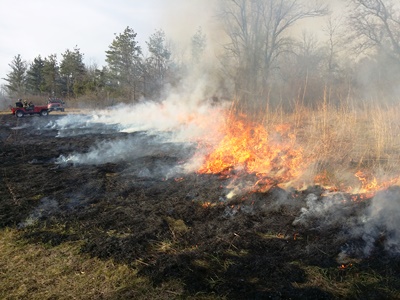Tallgrass prairie once covered up to 80 percent of the Iowa landscape. However, as acres of prairie disappeared, so did native wildlife populations and the water quality benefits prairie provided by slowing and filtering runoff.
The League’s Red Cedar Chapter (Iowa) has embarked on an ambitious program to prepare and reseed more than five acres of the chapter’s property as a showcase for prairie restoration. The long-range objective of the project is to restore native prairie and wildflowers, create an environment for education and bird watching, and help the community understand the multiple benefits of native prairie.
In 2015, the IWLA Endowment awarded the Red Cedar Chapter a $9,000 grant for this project. The chapter’s grant application contained a clear explanation of the project, including expected outcomes and a detailed budget.
An earlier attempt by the chapter to re-establish prairie grasses did not end well. Chapter members tilled the soil and planted prairie grasses but left the seeds of earlier grasses intact. The result was an area of switchgrass so mature that it simply choked out all other forms of native grasses. The lesson learned from this effort was that unless the switchgrass was completely killed, a successful restoration with a variety of native plants was simply impossible.
The area currently under restoration includes four distinct units – each with its own restoration requirements. Units 1 and 2 were covered with switchgrass and weeds. Units 3 and 4 can best be described as remnant prairie (and one of those units had been used as a cemetery for local residents’ pets!).
The chapter was fortunate to have a professional naturalist on the membership roster. Mark Pingenot advised the chapter on techniques and timing for seasonal burns, targeted plantings, and seedings, and he monitored mowings to ensure the establishment of healthy root systems.
 The process started with the local fire department, which sent firefighters to conduct grass fire trainings on the lots. They burned the entirety of the four units, destroying both plants and seeds. This was then followed by multiple applications of weed killer to units 1 and 2, which finally resulted in a clean slate from which to begin the restoration project. The process of regenerating native prairie becomes rather complex at this point, between burn cycles and targeted seeding, but the chapter is committed to a multi-year effort that will enhance community access to the prairie demonstration areas and increase native plant and wildlife populations.
The process started with the local fire department, which sent firefighters to conduct grass fire trainings on the lots. They burned the entirety of the four units, destroying both plants and seeds. This was then followed by multiple applications of weed killer to units 1 and 2, which finally resulted in a clean slate from which to begin the restoration project. The process of regenerating native prairie becomes rather complex at this point, between burn cycles and targeted seeding, but the chapter is committed to a multi-year effort that will enhance community access to the prairie demonstration areas and increase native plant and wildlife populations.
As part of the community outreach effort, chapter members constructed and installed 10 bluebird houses and a bird feeding station to encourage birdwatching. Ten viewing benches were constructed as part of an Eagle Scout project. The chapter will build viewing paths, and signs have already been installed to identify plants and animals typically found in the area.
Craig Hoepner, the chapter’s environmental education director and first vice president, has been the driving force behind this project. Hoepner and chapter president Bill Keller see this as an opportunity to share their experiences with other chapters interested in prairie restoration. For more information, contact Bill Keller at pres.redcedar@gmail.com.
The Red Cedar Chapter’s native prairie project is an excellent example of programs that support the mission and goals of the Izaak Walton League.
For more information about Endowment grants, including grant application forms, go to www.iwla-endowment.org. Applications can be submitted electronically.